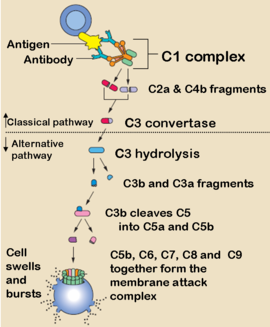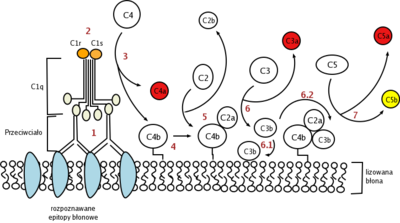
Classical complement pathway
Encyclopedia

Complement system
The complement system helps or “complements” the ability of antibodies and phagocytic cells to clear pathogens from an organism. It is part of the immune system called the innate immune system that is not adaptable and does not change over the course of an individual's lifetime...
is a group of blood proteins that mediate the specific antibody
Antibody
An antibody, also known as an immunoglobulin, is a large Y-shaped protein used by the immune system to identify and neutralize foreign objects such as bacteria and viruses. The antibody recognizes a unique part of the foreign target, termed an antigen...
response. The main activators of the Classical Pathway are antigen-antibody complexes.
Initiation
It is triggered by antigenAntigen
An antigen is a foreign molecule that, when introduced into the body, triggers the production of an antibody by the immune system. The immune system will then kill or neutralize the antigen that is recognized as a foreign and potentially harmful invader. These invaders can be molecules such as...
-bound antibody molecules. (The only antibodies capable of binding are two units of IgG or one IgM
IGM
IGM as an acronym or abbreviation can refer to:* Immunoglobulin M , the primary antibody against A and B antigens on red blood cells* International Grandmaster, a chess ranking* intergalactic medium* Intragroup medium - see: Intracluster medium...
, although IgM is more effective at activating complement. IgG4 cannot bind, but the other three IgG types can.) It is the binding of a specific part of the antibody molecule to the C1 component that initiates this pathway.
C1 and its subunits
This initial enzymeEnzyme
Enzymes are proteins that catalyze chemical reactions. In enzymatic reactions, the molecules at the beginning of the process, called substrates, are converted into different molecules, called products. Almost all chemical reactions in a biological cell need enzymes in order to occur at rates...
, C1, is a complex formed through a calcium
Calcium in biology
Calcium plays a pivotal role in the physiology and biochemistry of organisms and the cell. It plays an important role in signal transduction pathways, where it acts as a second messenger, in neurotransmitter release from neurons, contraction of all muscle cell types, and fertilization...
-dependent association between two reversibly interacting subunits, C1q and C1 (C1qr2s2). Approximately 70% of C1 is at all times present in this complex form. C1 occurs in serum as a proenzyme that tends to undergo autoactivation but is strictly controlled by C1-inhibitor
C1-inhibitor
C1-inhibitor is a protease inhibitor belonging to the serpin superfamily. Its main function is the inhibition of the complement system to prevent spontaneous activation. C1-inhibitor is an acute-phase protein that circulates in blood at levels of around 0.25 g/L. The levels rise ~2-fold during...
(C1-In or C1 esterase). Upon the binding of C1 to immune complexes by virtue of the affinity of C1q for immunoglobulins (to be specific, IgM and IgG), the controlling action of C1-In is overcome, and C1q effects activation of C1r2s2.
C1q possesses no intrinsic catalytic activity, but, when any of several activators bind to the C1q subcomponent of C1, the homologous C1r and C1s subcomponents are converted into catalytically active species, namely C1r* and C1s*, triggering the first step of the classical pathway of complement activation.
Thus, on binding to immune complexes through C1q, the subunits of C1 become firmly associated and autoactivation commences even in the presence of the Cl-In.
Steps leading to C3-convertase
At first, a conformational change in C1r occurs, followed by proteolytic activation, which results in the cleavage of all four polypeptide chains of C1r2s2.
C3-convertase
There are two forms of C3-convertase .* The first is an enzyme composed of the C4b-C2a complex, which forms during the classical or lectin pathways of the complement system. It is formed when C1s cleaves off a small peptide fragment of C2 C2b from a membrane-bound C4b-C2a complex.* The second...
, C4bC2a, which has been formed from C2
Complement component 2
Complement C2 is a protein that in humans is encoded by the C2 gene. The protein encoded by this gene is part of the classical pathway of complement system.-Further reading:...
and C4
Complement component 4
Complement component 4 is a protein involved in the complement system.It is cleaved into proteins 4a and 4b.* C4a is an anaphylatoxin.* C4b forms part of C3-convertase, in conjunction with 2a:* C4b can bind CR1....
.

